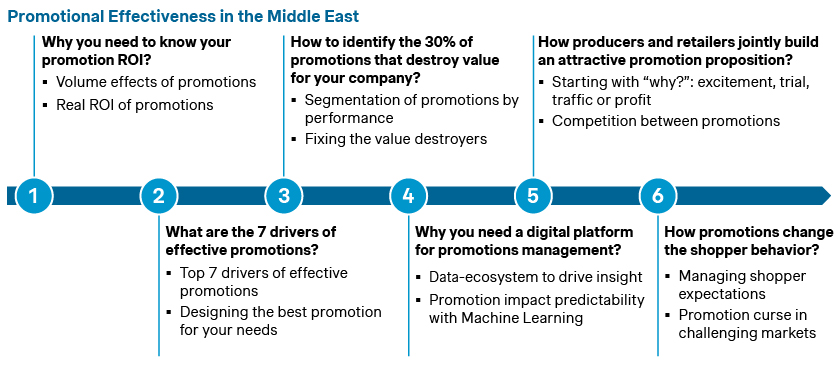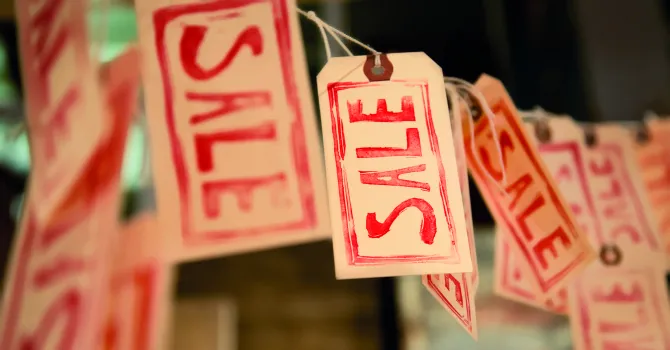Consumer companies in the MENA region should be cautious about implementing value-destroying promotions. While promotions can be an effective tool for driving sales and increasing market share, poorly executed or overly aggressive promotions can have negative consequences that outweigh the benefits. In part 3 of our series, Lovrenc Kessler provides strategies to identify and fix them.
There is a prevalence of promotions and discounts across various consumer sectors, with some companies relying heavily on promotions as a means to drive short-term sales.
As the number of promotions grows, consumers begin to expect one great deal after the other and become reluctant to purchase products at the regular shelf price. Intense competition for customers and revenue only results in margin dilution.
For consumer goods companies, promotions offer a valuable opportunity to attract new customers, boost sales volumes, and generate awareness of new launches – as long as they consider the seven drivers of effective sales promotions discussed in our last article.
Too many promotions, too little profitability monitoring
With limited financial monitoring in place, discounting is often implemented incorrectly, leading to what we call “value-destroying” promotions. These hurt businesses in the long run.
Value destroying promotions have a negative return on investment (ROI) and fail to generate a substantial volume increase. They are mainly caused by companies neglecting to monitor how profitable their promotions are due to a lack of capabilities to allocate costs and track the real volume effects.
Promotion segmentation to identify "value destroyers"
To successfully identify value-destroying promotions, companies should carry out segmentation based on volume impact and ROI. We explained how to calculate promotion ROI and presented five volume effects in an earlier article. Promotion segmentation for consumer goods companies typically looks like this:

Based on our experience in optimizing promotions for FMCG companies across industries, typically 30 to 40 percent of promotions are value destroyers yielding a negative ROI and limited volume impact – a major opportunity to improve profit. Companies need to optimize these promotions according to their respective objectives. This means either improving the promotion design to increase volume or limiting the promotion cost to generate a better financial return.
How to deal with value destroyers
As soon as you have identified value-destroying promotions, you can start fixing them. There are five main improvement levers to increase the effectiveness of your promotion:
- Optimize the discount
Smaller discounts, like 30 percent instead of 40 percent, usually mean moderate losses in volume but major improvements in profitability. Companies often make the mistake of copying their competitors’ actions even if they have different objectives. For example, if a market challenger offers significant discounts to gain market share, the leader should not aggressively follow suit, accepting they’ll lose profits. - Decrease the frequency of promotions
Fewer promotions help prevent customers from becoming too used to buying items only when they’re on sale. Companies should plan attractive promotions less frequently to stimulate trial, grow their customer base, and avoid cannibalizing loyal customers. - Invest more in promotion activation
It’s a good idea to invest in activation measures instead of doing one promotion after another to improve promotion performance. In addition to placing an ad in the front or back page of a leaflet, secure extra placement in stores at the end of the aisle or launch digital campaigns for top sellers to make a bigger impact on sales numbers. We know from experience that good secondary placement in stores can generate an additional 70 percent in promo sales! - Revise your choice of products
Certain products will never generate a positive ROI on promotion due to a variety of reasons. Their profitability might be low, promotion uptake could be limited, or they may significantly cannibalize other products. These products should only be promoted if 1) the strategic objective is to activate these products (e.g. generating trial or up-selling from a cheaper alternative) and 2) the promotions have a major impact on sales volume. If there is no strategic objective behind it, don’t lose money by promoting these products. - Reallocate promotion budget between accounts
Just because a promotion was successful at one retailer doesn’t mean it’ll necessarily do well at another. The differences in performance could come down to multiple factors, such as the customer characteristics in a specific store or the additional support offered by the retailer. Whatever the cause, it’s important to compare the promotion performance between retailers in order to allocate your budget effectively and determine your yearly activity plan.
Certain promotions will simply fail to generate a positive ROI and volume impact, resulting in pure value destruction for companies. To prevent ineffective promotions from seriously harming your business in the long run, you should first identify the 30 to 40 percent of your promotions that are value destroyers. As a second step, use the drivers mentioned above to sustainably improve promotion effectiveness and revenue growth.

Read more from our promotional effectiveness series in the Middle East:
Part 2: The 7 drivers of effective sales promotions in the UAE
Part 3: Promotion effectiveness in MENA: How to fix the 30 percent of value-destroying promotions
Part 4: Digital promotions in MENA: Advantages of promotion database management
Part 5: 5 rules for producers and retailers to jointly build customer-centric promotions
Part 6: Promotion effectiveness in MENA: How do promotions change shopper behavior in the long term?








